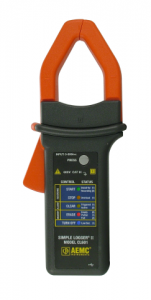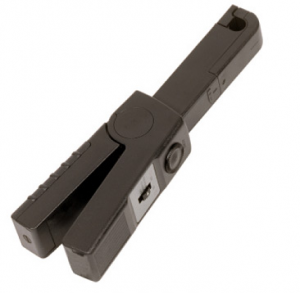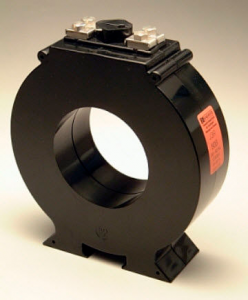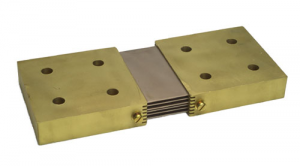…current is always measured indirectly from an external sensor that produces a voltage output that is proportional to current. Since the only difference between a voltage and current measurement is the scaling that you apply to the result, voltage measuring instruments are almost always used to measure current.

Model CL601 current data logger is a rare example of an instrument with a built-in current sensor (click for details.)
We often run across applications that require general-purpose AC or DC current measurement. In many cases, customers are surprised to learn that dedicated current measurement options appear to be limited.Simply stated, this is because current is always measured indirectly from an external sensor that produces a voltage output that is proportional to current. Since the only difference between a voltage and current measurement is the scaling that you apply to the result, voltage measuring instruments are almost always used to measure current.
The only exception to the above are instruments that happen to have a current sensor built into them, which is very unusual. An example is model CL601 AC Current Data Logger from DATAQ Instruments (see accompanying picture), which features a built-in, clamp-type current probe to accommodate AC current measurements.
Some examples are in order to crystallize the much more common concept of using voltage instruments to measure current, and they are best categorized based upon the most common types of current sensors.
Current Measurement Using Shunts
A current shunt is a precision resistor of very low value that is installed in series with the conductor from which current will be measured. Since its output is scaled to produce typically 50 or 100 mV at full-scale current, a voltage measuring device is used with the result scaled into units of current.
Instrument sample rate comes into play with ac current measurements, since the shunt passes an unfettered current waveform. In cases like that, you might connect an RMS voltage amplifier to the shunt’s output to generate a DC output that is proportional to RMS current, minimizing both sample rate and the size of recorded files.
Note that the instrument used to measure current shunt voltage will often need to be isolated.
Current Measurement Using Probes

Example of an AC/DC current probe sold by DATAQ Instruments. Powered by a 9-V battery, the probe outputs a DC voltage proportional to applied DC and AC RMS current (Click for more information)
Current probes provide the convenience of being hung on, or wrapped around a conductor. Unlike current shunts, they do not require that you install them in series, and all provide inherent isolation. However, these conveniences come at the price of accuracy and price when compared to current shunts.
Some current probes measure AC and DC current, and others only measure AC. Further, some probes provide built-in amplifiers that produce an RMS output for AC current measurement. Those that do not yield a current waveform. So, care should be exercised when matching a probe to an instrument, especially for AC measurements. It wouldn’t make sense to use a probe without an RMS amplifier to measure 60 Hz line current using an instrument that can sample at only a 10 Hz rate.
Current Measurement Using Current Transformers
The final method commonly employed to measure current is a current transformer (CT). Some CTs can be used to measure AC and DC current, but most measure only

A typical current transformer. A conductor is passed through the hole, and an output is provided for indirect current measurement by a voltage measuring instrument.
AC current. CTs commonly have a hole in them through which the conductor is passed, and an output for connecting to a measuring instrument. The output is actually a current output and must be shunted with a known resistance to develop a voltage. Failure to do so results in extremely high and possibly lethal voltages present on the secondary, so be sure to carefully read and follow the manufacturer’s operating instructions.
Match the Current Sensor to the Instrument
Whether you choose a current shunt, probe, transformer, or some other current sensor, the key takeaway from this article is that current measurement is always a voltage measurement by any other name. So it follows that the the same precautions you’d exercise to measure voltage apply equally to measure current:
- Ensure that the expected output voltage range of the current sensor is within the measurement range of the instrument.
- Ensure that the instrument has the sample rate flexibility to provide meaningful results if the sensor passes a true current waveform.
- Ensure that you understand the isolation requirements of the measurement, and use a suitably isolated instrument if required.
Additional Reading:
Isolated mV amplifiers suitable for use with shunts
Using WinDaq software to calculate true RMS
Learn the Importance of Isolation in Four Easy Lessons


 View Cart
View Cart sales@dataq.com
sales@dataq.com 330-668-1444
330-668-1444